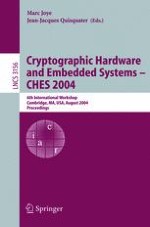2004 | OriginalPaper | Chapter
How to Disembed a Program?
Authors : Benoît Chevallier-Mames, David Naccache, Pascal Paillier, David Pointcheval
Published in: Cryptographic Hardware and Embedded Systems - CHES 2004
Publisher: Springer Berlin Heidelberg
Included in: Professional Book Archive
Activate our intelligent search to find suitable subject content or patents.
Select sections of text to find matching patents with Artificial Intelligence. powered by
Select sections of text to find additional relevant content using AI-assisted search. powered by
This paper presents the theoretical blueprint of a new secure token called the Externalized Microprocessor (XμP). Unlike a smart-card, the XμP contains no ROM at all.While exporting all the device’s executable code to potentially untrustworthy terminals poses formidable security problems, the advantages of ROM-less secure tokens are numerous: chip masking time disappears, bug patching becomes a mere terminal update and hence does not imply any roll-out of cards in the field. Most importantly, code size ceases to be a limiting factor. This is particularly significant given the steady increase in on-board software complexity.After describing the machine’s instruction-set we introduce a public-key oriented architecture design which relies on a new RSA screening scheme and features a relatively low communication overhead. We propose two protocols that execute and dynamically authenticate arbitrary programs, provide a strong security model for these protocols and prove their security under appropriate complexity assumptions.
